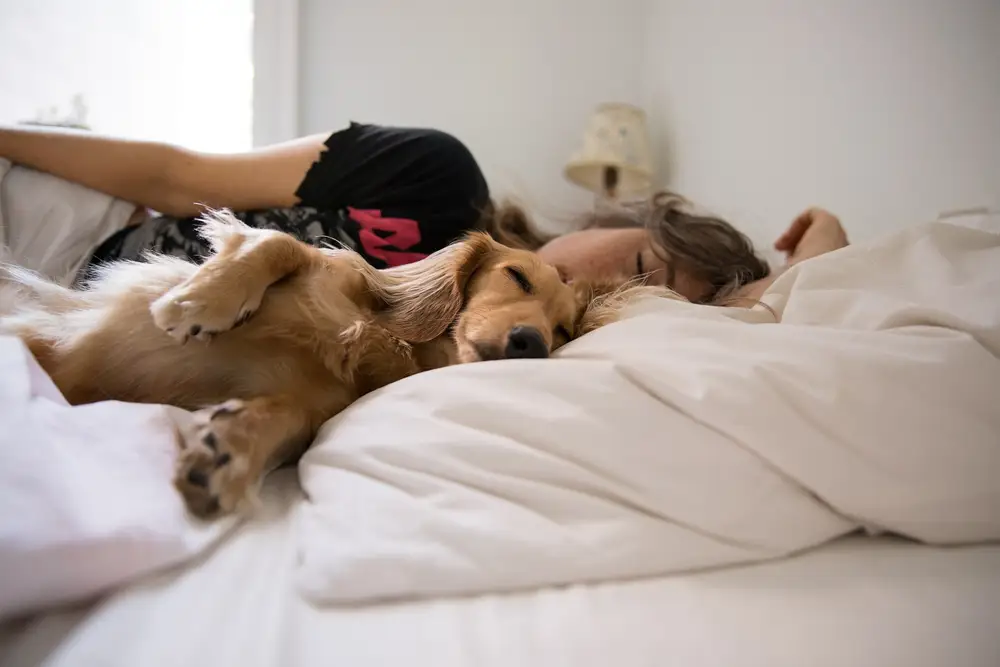Co-sleeping with your pet can be good for your bond but not for you. Here’s when you might need a sleep divorce.

Sharing a bed with your pet can provide comfort but also it can disrupt your sleep.
If you’ve been scrolling through social media lately, you’ve probably seen videos of people letting pets sleep in their beds. I admit it: my dogs sleep with me, too.
In one video, creator Johnathan Lower demonstrates how he has to twist his body into uncomfortable positions so as not to disturb his Golden Retriever, who is soundly asleep next to him. The video shows his dog hogging the blanket, breathing in his ear, and blocking his partner from touching him.
The most relatable moment for me is Lower waking up alone and wondering where his dog went. Sharing your bed with a pet is kind of like being an amateur contortionist, but it can also be a good bonding experience.
Given the importance of sleep for overall health and well-being, you might be wondering if having pets in the bedroom is a good idea. We asked a sleep expert and a veterinarian about the benefits and drawbacks of co-sleeping with pets and how to decide if you need a “sleep divorce” from your beloved companion.
Co-sleeping with a pet has advantages
Cuddling with a pet can provide a sense of comfort and security. So, it’s only natural that you’d want to extend these intimate moments by allowing your pet to sleep in your bed.
Research shows that co-sleeping with pets can have a positive or neutral effect on sleep quality. And because pets thrive on having a routine, they might even encourage you to develop a consistent sleep schedule.
“Co-sleeping with a pet can help with anxiety and stress levels, which could help you sleep better,” Shelby Harris, director of sleep health at Sleepopolis, told B-17. If you live alone or struggle with nightmares, having a pet nearby can be a source of emotional support and companionship.
Since animals tend to give off heat while sleeping and their body temperature is higher than ours, dogs, in particular, can make your bed feel warm and cozy, Amy Attas, a veterinarian and founder of New York-based practice City Pets, told B-17. In addition, people with cats may find it soothing to listen to the sound of purring.
Pets can also interrupt your sleep
While co-sleeping may enhance the human-pet bond, pets can disturb your sleep by moving around, snoring, or vocalizing in their sleep, Harris said. A recent study found that co-sleeping with pets can contribute to poorer sleep quality and more severe insomnia.
Given their exceptional hearing, pets may be awakened by sounds that people can’t hear, causing sleep disruptions. “Pets who are startled in their sleep may have an aggressive response toward the individual in the bed,” Attas said.
Pets can get sick in the middle of the night and vomit or have diarrhea in bed. “Indoor cats can track soiled kitty litter onto sheets and pillowcases in close contact with a person’s face,” Attas said. Older pets or those with kidney disease may be prone to urinary incontinence.
If your pet goes outdoors, they can introduce dirt and bacteria into your bedroom, affecting the cleanliness of your bed and your health, Harris said. Breathing in pet dander can worsen allergy and asthma symptoms.
The type of pet matters, and where they sleep
Once you’ve fallen asleep, staying asleep can be challenging with larger pets or multiple pets taking up space. On the other hand, a large breed dog might have a calmer temperament than a smaller or younger dog who gets the zoomies or a cat who enjoys playing at night.
As nocturnal animals, cats tend to be more active at night and in the early morning, which can cause more frequent sleep disturbances, Harris said. In contrast, dogs tend to be more adaptable, eventually mirroring their owner’s sleep schedule.
During the night, cats may change locations, even sleeping on top of their owners’ heads or pillows. Likewise, “dogs tend to reposition themselves more as they relax, which can be disruptive,” Attas said.
Some pets, because of age or mobility issues, may require help with getting on or off the bed overnight. They may also need to stretch or change positions to relieve pressure on their joints.
How to improve sleep when co-sleeping with a pet
Having a consistent bedtime and wake-up time can be helpful and keep your pet from getting too excited at night. “Make sure your pet is well-exercised and has gone to the bathroom to minimize any night-time activity,” Harris said.
If you’re sharing a bed with your pet, “ensure your bed is large enough to fit you and your pets comfortably,” Attas said. You may wish to purchase a waterproof pad to protect your mattress from urine or vomit.
Both experts recommended regular grooming and cleaning to keep your bedroom hygienic and reduce exposure to allergens and parasites. For extra protection against pet dander, consider buying an air purifier with a HEPA filter.
Attas said that in addition to training your pet to discontinue disruptive behaviors, you can also use an eye mask and a white noise machine to reduce noise from pets. She also suggested putting your pet’s favorite bed on top of your bed to encourage them to stay in one place.
If all else fails, a good compromise would be letting your pet sleep in the same room but not in your bed. This setup can help you enjoy your pet’s companionship while allowing you to have a restful sleep environment, Harris said.
What to do if it’s time for a sleep divorce
Helping your pet transition out of your bed and into his or her own space requires patience and consistency. If your pet is accustomed to sleeping on a spacious and comfortable mattress, be sure to invest in a high-quality pet bed and introduce it to your pet on your bed, initially, Attas said.
Place the bed close to where your pet had been sleeping, along with your pet’s favorite toys and blankets. Then, sit with your pet on or near the new bed and lie down close to it.
Pair commands like sit or down with “positive reinforcement such as a delicious treat to encourage your pet to spend time on the new bed,” Attas said. “Provide additional reinforcement if the pet goes to the new bed on their own.”
If they jump on your bed, you can gently nudge them off or redirect them to their new bed using a treat. You can also consult with your veterinarian about ways to ease your dog’s anxiety during the transition.






